::: Island of Maui Postmarks, Part 3 - Lahaina to Peahi :::
|
|
 Back to Islands of Maui, Molokai and Lanai.
Back to Islands of Maui, Molokai and Lanai.
|
|
|
Official mail (cover front) bearing the Lahaina custom seal, type 303,
docketed June 9, 1860, and addressed to the Board of Education at Honolulu
|

|
Lahaina, Lahaina District
"cruel sun" - named for droughts
1851-1900
|
|
|
A mission station beginning in 1823 and favorite whaling port, Lahaina was favored by Kamehameha III as his residence (and thus where the royal court and government sat) until 1846, when the government seat moved to Honolulu. Lahaina remained a significant whaling port and in the sugar boom was home to the Pioneer Mill. Lahainaluna Seminary, located just uphill from Lahaina, accounted for some of the correspondence passing through the Lahaina post office. The seminary was established in 1831 and is where the first Hawaiian newspaper was printed in 1834. Starting at least by the early 1870's Lahaina declined as a center of society and commerce and around 1880 was overtaken as Maui’s principal town by Wailuku. In 1880, Lahaina lacked a hotel, but had three restaurants, around a dozen stores and about 250 houses.
Customs Collectors: Isaac Lewis (1844), Edward Hawks (1844), H. S. Swinton (1844-1851), R. H. Bowlin (1851), Svend Hoffmeyer (1851), George D. Gower (1851-1854).
Postmasters: Cornelius S. Bartow (1854-1862 [customs collector and postmaster]; T. H. Treadway (1862-1872) [sheriff]; Thom. W. Everett (1872) [sheriff]; William O. Smith (1872-1874); Thom. W. Everett (1874-1885); R. Newton (1885) [notary]; H. Turton, Sr. (1885-1887; but Harry Turton, Jr. signed as acting PM in 1886); T. E. Evans (1887)[deputy sheriff]; M. Makalua (1887)[deputy sheriff]; H. Turton, Jr. (1887)[laborer]; T. E. Evans (1887-1890)[deputy sheriff]; Capt. D. Taylor (1890-1891); T. C. Forsyth (1891-1896)[carpenter]; A. A. Hayselden (1896)[deputy sheriff]; G. W. Hayselden (1896-1899); and A. Waal (1899-1900).
Originally the post office was part of the customs officer’s duties. In 1860 the post office was moved into the court house. PMG Oat described Lahaina as a post and money order office in his 1893 trip report and said the post office was situated in the court house “where it has been located for years.” The office had 120 lock boxes, only a third were rented. Oat contrasted it to earlier years when 120 boxes were rented and weren’t enough. (Hawaiian Gazette, October 17, 1893, p. 10.) In February, 1892, PM Forsythe reported that every month he processed about 400 letters going to Hawaii, Molokai or other Maui towns, plus some unstated number of letters addressed to Oahu, Kauai or abroad.
Lahaina was home to several firms providing letter forwarding services. Whalers who set out for the hunting grounds before homeward bound ships were set to depart left their letters with forwarders to be put in a ship’s letter bag when the season arrived to round Cape Horn. Other sources of forwarded letters were American settlers in other places such as Oregon and Mexico’s Alta California who sent their letters to Hawaii in search of a homeward bound ship. Lahaina forwarders included von Pfister & Co. (1842), B. F. Bolles & Co. (late 1850's to 1861), Bush & Co. (1847-1855), G. D. Gilman (1855-1857), Waldo & Co. (1846-1847), Rev. Dwight Baldwin and the United States Consular Agent (technically, the Vice Commercial Agent) appointed for Lahaina.
|
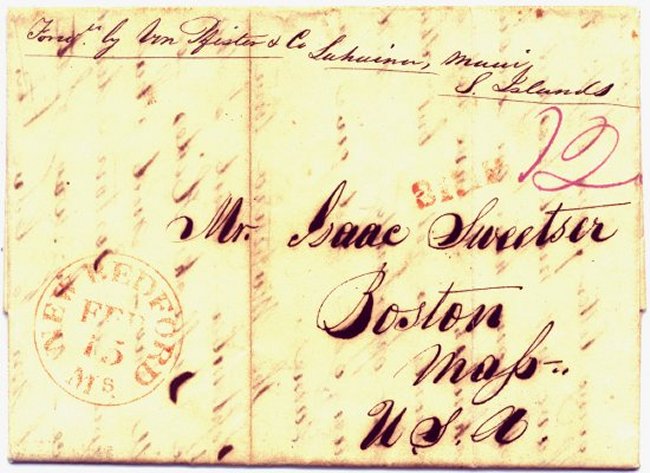
|
|
Dateline April 1, 1842 at Yerba Buena, Alta California and forwarded to Boston from Lahaina by Von Pfister & Co. with the unique manuscript mark of that company; the earliest documented forwarder mark in Hawaii.
|
|
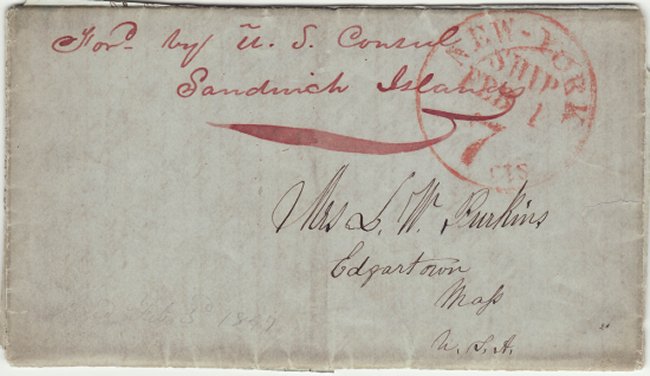
|
|
Dateline Mowee, April 24, 1846, and forwarded to Edgartown, MA by the U.S. Consul at Lahaina.
|
|
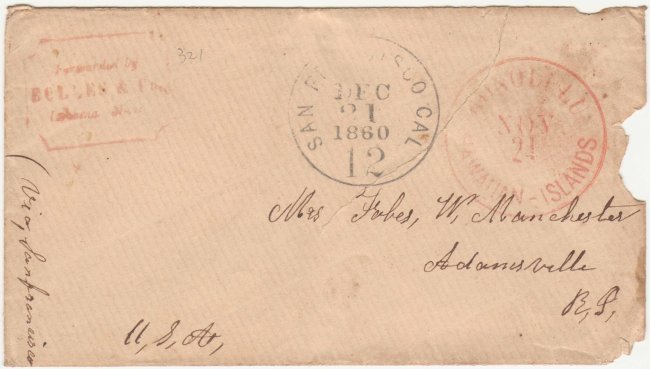
|
|
From Lahaina to Rhode Island, Nov. 24, 1860 with a Bolles & Co., Lahaina, truncated box forwarding mark in the upper left corner.
|
|
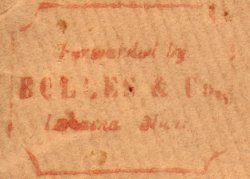
Forwarded by Bolles & Co.
Lahaina, Maui
|
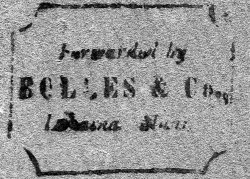
(retroReveal enhanced)
|
|
Mail service between Lahaina, Honolulu and other interisland ports was direct by sailing ships or steamers. Lahaina was the hub for the overland mail service on West Maui. Stamp sales in 1884-1885 were about $365 annually and the postmaster was paid $100 per year. Stamp sales in 1898 were $900 and the postmaster received a salary of $75. Until 1860, the post office was located in the customs house and then was moved to the government office near the landing.
Rev. Serano Bishop, who received and retained much mail, moved to Lahainaluna Seminary in 1865. He carefully docketed each cover with the name of the sender, the date of the contents and the date acknowledged. Surviving covers from his correspondence constitute a large percentage of saved local mail and are keys to proving the printing shades of early Bank Note 2¢ stamps.
In 1896, the Lahaina PM reported that Chinese residents were sending large packages through the mail to someone in Honolulu with letters addressed to China. He complained that the post office was losing money on postage.
In addition to postmarks used at Lahaina, the first postmaster, C. S. Bartow, canceled stamps with a handstamp bearing his name. Bartow served as postmaster until 1862, when the job was combined with the sheriff and Treadway automatically became postmaster in the wake of funding cut backs necessitated from the loss of the whaling fleet in 1860.
|
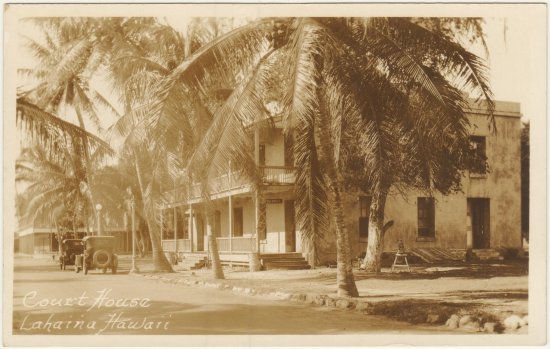
|
|
Lahaina court house, as it appeared when it opened in 1859 until 1925, when changes were made to the facade. The building housed the early post office, custom house and other government offices in addition to the court.
|
|
|
303
Custom House mark used as a postmark
Custom House/Lahaina Maui H.I.; full rigged sailing ship at center; outer ring is made of dots.
Color: Blue, Black,
Orange
Rarity: 2, 29 strikes are in my record.
Usage: September, 1859-June, 1860
The orange strike was offered in the Advertiser Sale as lot 259. The black strike was offered at Siegel auction 1192 as lot 994. All other recorded strikes are blue.
Noted on Numeral stamps from Plate 2-A to Plate 3-G.
|
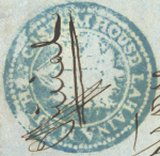
June 9, 1860
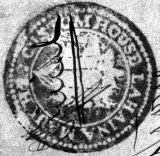
June 9, 1860
(retroReveal enhanced, www.retroreveal.org)
|
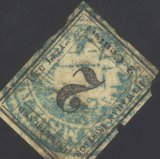
Scott No. 16, Plate 3-C-VII
| | | | |
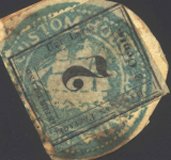
Scott No. 16, Plate 3-D-III
|
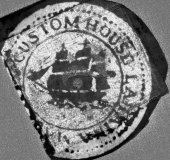
Scott No. 16, Plate 3-D-III
(retroReveal enhanced)
Early sharp impression
|
|

|
|
C. S. Bartow
manuscript, straight line handstamp
Color: Blue
Rarity 1RRR, four strikes are in my record.
Usage: 1859-1860
With no town reference, this cancel is shown for reference but is not counted as a postmark.
|
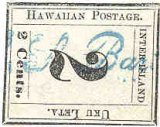
Scott No. 16, Plate 3-D-V
C. S. Bartow manuscript
|
|

|
|
243.02
35mm single lined circle; boxwood device
Color: Blue, Black,
Green
Scarcity: 2, 32 strikes are in my record.
Usage: July 25, 1862 to February 23, 1865
Green is more blue-green than a true green.
Late strikes noted on Scott No. 31 (1864 printing).
|
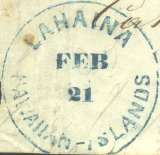
Scott No. 27
February 21, ____
| |
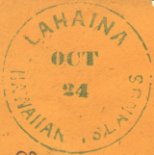
Oct 24, 1863
(blue-green)
|
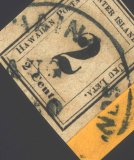
Scott No. 16, Plate 2-F-I
August 30, ___ (black)
|
|
|

|
|
802a
Lahaina/P.O./Paid
manuscript
Color: Purple
Rarity: 1RRRR, one example is in my record, ex-Davey.
Noted on Scott No. 31
|
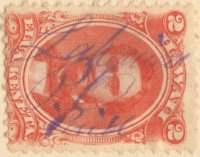
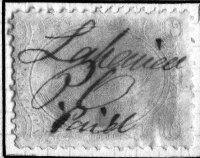
(retroReveal enhanced)
|
|
|

|
|
242.13
34mm single lined circle; steel or brass device
Color: Black
Scarcity: 2, 22 strikes are in my record.
Usage: March 22, 1867 to January 3, 1879
The device for this mark was made by Thomas Tannatt of Honolulu in May, 1866.
|
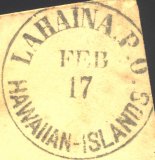
February 17, 1868
| |
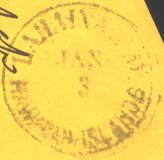
January 3, 1879, LDU
|
|
|

|
|
238.02
30mm single lined circle; brass device
Color: Black
Scarcity: 2, 21 strikes are in my record.
Usage: July 4, 1879 to August __, 1885
|
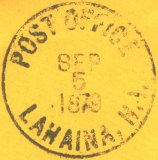
September 5, 1879
|
|

|
|
282.012
33mm double lined outer and single lined inner circles
Color: Black
Rarity: 1RRR; nine strikes are in my record.
Usage: September 5, 1883 to July 4, 1884
|
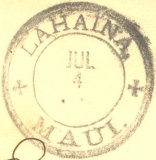
July 4, 1884
|
|

|
|
281.013
30mm double lined outer and single lined inner circles; large stars. Strikes up to August 28, 1886 show the date sideways, with the month at the right.
Color: Blue, Purple
Estimated: 6
Usage: September __, 1885 to February 14, 1893
Purple is noted on a strike dated April 6, 1891.
PM Forsythe complained in April, 1891 that his date stamp had no April and no numbers for 27 and 29.
|
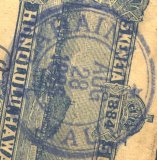
August 28, 1886
date is sideways
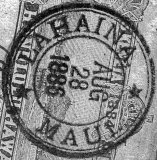
August 28, 1886
date is sideways
(retroReveal enhanced)
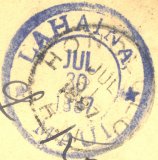
July 30, 1887
date is correctly oriented
|
|

|
|
281.01
30mm double lined outer and single lined inner circles; late period strikes have a single lined outer circle due to ink clogging and wear
Color: Purple, Blue
Estimated: 6
Usage: May 17, 1886 to February __, 1891; August 18, 1898 to May __, 1900; I record one strike during the "gap," dated January 4, 1896
Blue strikes are noted to late 1889.
|
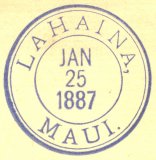
January 25, 1887
|
|

|
|
281.011
31mm double lined outer and single lined inner circles
Color: Purple, Black
Estimated: 7
Usage: April __, 1893 to July __, 1898
Black, actually grayish, is the predominant color for this mark. Purple strikes are scarce. The example shown reflects purple under white light.
|
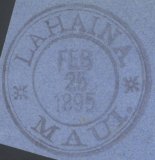
February 25, 1895, gray
| |
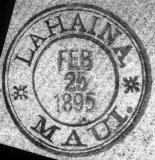
February 25, 1895, gray
(retroReveal enhanced)
|
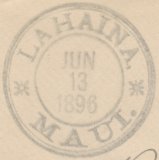
June 13, 1896, gray
| |
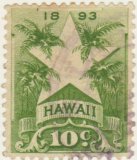
Purple
|
|
|

|
|
253.9a1
27mm double lined circle; duplex cancel; town letters are 0.3mm from innermost circle; ink clogged the space between the outer circles in later strikes.
Color: Purple, Black
Estimated: 8
Usage: January __, 1898 – April 14, 1900
|
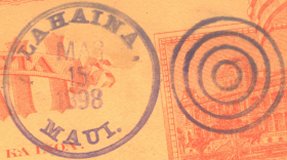
March 15, 1898
|
|

|
|
255.9a1
29mm double lined circle; duplex cancel; town letters are 0.7mm from innermost circle
Color: Purple
Scarcity: 4
Usage: January 12, 1900 – June 13, 1900
|
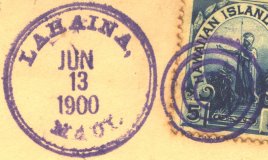
June 13, 1900, the last day of the independent Hawaiian postal service. The next morning at 12:01 AM, Hawaii became a territory of the United States
|
|

|
Lahaina Sugar Co., Lahaina District
1861
Postmaster: O. R. Wood
If there was a postal service at this place independent of the Lahaina Post Office, it must have been a postal agency as there is no record of stamp sales for an office here. No postmarks are known.
|

|
Maalaea, Wailuku District
uncertain translation, possibly "ocherous earth beginning"
1884-1890
|
|
|
Before the wharf was completed at Kahului, on the opposite side of the isthmus, Maalaea was the principal landing for Maui, handling most mail and cargo, owing to its position on the leeward side of the island. After Kahului’s wharf was done, Maalaea handled less cargo but remained an important mail landing on the interisland steamship routes between Lahaina and the Big Island.
|
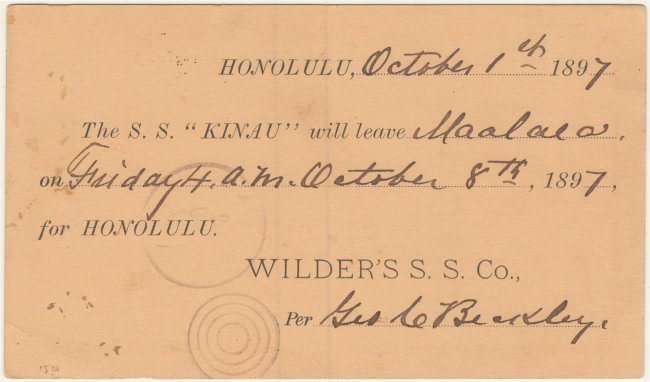
|
|
A typical post card sent by Wilder’s Steamship Company to Maui postmasters advising them of the timetable for steamships landing or picking up mail at Maalaea. This card bears an October 3 Paia type 253.9a1 postmark.
|
|
A postal facility at Maalaea was mentioned by Davey, but no listing for this office appears is in the post office reports. PMG Oat made no mention of Maalaea except as a landing place in his 1893 trip report. It is doubtful that a postal facility was located at Maalaea. (Hawaiian Gazette, October 17, 1893, p. 10.)
No postmarks are known.
|

|
Makawao, Makawao District
"forest beginning"
1854-1900
Located upland on the northwest slope of Haleakala. Site of a church established by Rev. Jonathan Green in 1842 and headquarters for the McLane Sugar Plantation, a pioneer plantation started in 1846. Makawao remained a sugar plantation town for the remainder of the century and was the principal town of the district until overtaken by Paia in the 1880's. Makawao had two schools, a boarding school for girls run by Miss Carpenter and Miss Mary Parker and a military board school for boys run by Prof. F. L. Clarke.
|
|
|
Postmasters: L. L. Torbert (1854); G. M. Spencer (1856-1861); Needham & Co. (1861-1862); J. T. Wise (1862); T. H. Everett (1864); J. D. Gower (1864); P. J. White (1865); P. Cole (1865); J. D. Gower (1865); __ Fixen (1865); N. F. Sayre (1866-1869); J. J. Halsted (1875) [notary]; George Gray (1875-1877); W. L. Davis (1877-1880) [storekeeper and butcher]; James Anderson (1881-1889) [grocer]; John G. Anderson (1889-1894) [coffee planter, James Anderson’s nephew who served as PM while James Anderson was in the legislature]; and James Anderson (1894-1900). PMG Oat described Makawao as a post and money order office in his 1893 trip report. (Hawaiian Gazette, October 17, 1893, p. 10.)
Mail service was by the overland carrier. In 1854, Makawao was listed as a stop on the overland route and carried the name Makawao-Kula in 1859. A carriage road built in 1864 between Wailuku and Ulupalakua passed through Makawao. Weekly mail service existed until about 1889 when twice weekly service was started from Paia and became a daily service in 1890. In 1894, Makawao had a daily mail service from Wailuku.
Early postmasters were appointed by the postmaster of Lahaina. In 1859, the post office was located at Spencer's store near Paia. When Needham took over the post office, he moved it to Makawao. In the late 1860's, the office was using annually about 40 sheets of 2¢ stamps and 4 sheets of 5¢ stamps. In 1884-1885, stamp sales at Makawao were about $110 annually. From 1887-1894, Makawao sent 6,000 to 7,000 letters each year. Stamp sales in 1898 were $240.
|
|
243.22
35mm single lined circle; steel or brass device
Color: Black
Rarity: 1RR; 17 strikes are in my record.
Usage: September __, 1870 to August 1, 1879
|
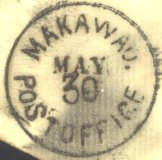
May 30, 1879
|
|

|
|
238.02
30mm single lined circle; steel device
Color: Black
Scarcity: 2
Usage: July 18, 1879 to August 25, 1883
|
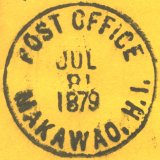
July 18, 1879 (day inverted)
|
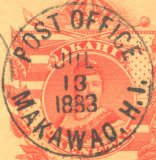
July 13, 1883
|
|
|

|
|
282.012
33mm double lined outer and single lined inner circles; dates often fail to print and in late uses show extreme wear
Color: Purple, Blue,
Black
Estimated: 7
Usage: May 1, 1880 to April __, 1897
Black strike noted September 21, 1883; blue strikes noted from '84 to March, 12, 1886; purple thereafter.
|
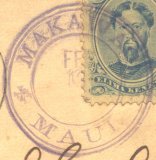
February 13, 1885
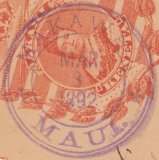
March 3, 1892
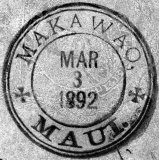
March 3, 1892
(retroReveal enhanced)
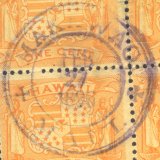
February 27, 1896
|
|

|
|
281.011
821 (manuscript date)
29mm double lined outer and single lined inner circles; the date failed and printed as a blot for a short time in 1899. Strikes often are misshapen.
Color: Purple, Black
Estimated: 6
Usage: June __, 1897 to May 9, 1900
Dark purplish black noted in October, 1899, changing to black strikes by late October. Earlier strikes are purple and the color returned to purple by April, 1900. Oblong and oval shaped marks are noted.
As 821 (manuscript date)
Scarcity: 2, 20 examples are in my record.
Usage: January 6, 1900 to May 19, 1900.
The latest readable postmark date I record for 281.011
is October 21, 1899. The date became blurred, then turned into a blob and finally failed to print resulting in type 821.
|
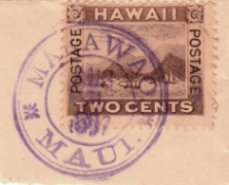
August 21, 1897
(Courtesy of James Shaffer)
|
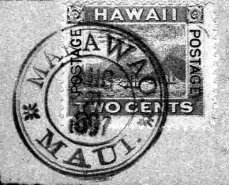
August 21, 1897
(retroReveal enhanced)
|
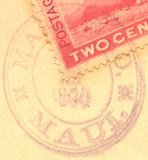
April 29, 1899, oval shape
|
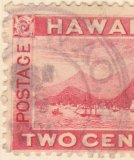
1899, blurred date
|
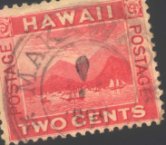
blot, 1899, blob for date
|
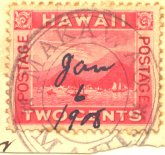
January 6, 1900 manuscript, EDU
(Courtesy of Phil Kay)
|
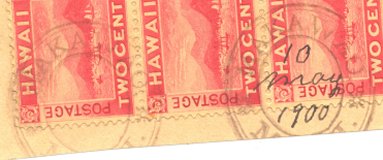
May 10, 1900
|
|
|

|
|
259.01
33mm double lined circle; town letters are 0.7mm from innermost circle
Color: Purple
Rarity: 1RRR; six strikes are in my record
Usage: May 17, 1900 – July 14, 1900
|
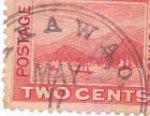
May 17, (1900), EDU
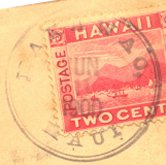
June 11, 1900
(Courtesy of Gary Peters)
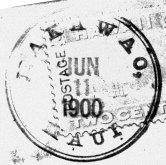
June 11, 1900
(retroReveal enhanced)
|
|

|
Makena, Wailuku District
"abundance" [Pukui]; "mourning for the dead" [Davey]
1888-1900
Makena was a port where mail to or for other Maui post offices could be landed or loaded and processed at Ulupalakua.
|
|
|
Postmasters: J. Kukahiku (1888-1890); P. W. Simeona (1890-1894); J. M. Napoulou (1894-1900).
In 1888, the Ulupalakua PM wrote that J. Kukahiku lived at Makena landing and “takes care of the Kahoolawe letters and papers until their boat comes over.” In 1889, Thomas W. Gay of Kahoolawe Ranch wrote that a native living at Makena took care of the ranch mail but that the post office was at Ulupalakua. It seems Kukahiku was an informal postal agency more or less supervised by the Ulupalakua postmaster. Simeona’s official title might have been postal agent, but he was addressed as postmaster in correspondence from the PMG in 1890-1894. However, in his 1893 trip report (Hawaiian Gazette, October 17, 1893, p. 10.), PMG Oat only mentioned Makena as a landing. Makena was recognized as a post office during Napoulou’s tenure as postmaster.
From 1890 to 1894, about 2,500 letters were sent from Makena annually and about 2,000 letters were sent there annually but it all was from or to other places. Stamp sales in 1898 were $90 and in 1899 were about $55.
After port facilities were developed at Kahului, Makena continued to be an important landing for mail and stop for the interisland steamships, as is demonstrated by the mail bag shown below.
|
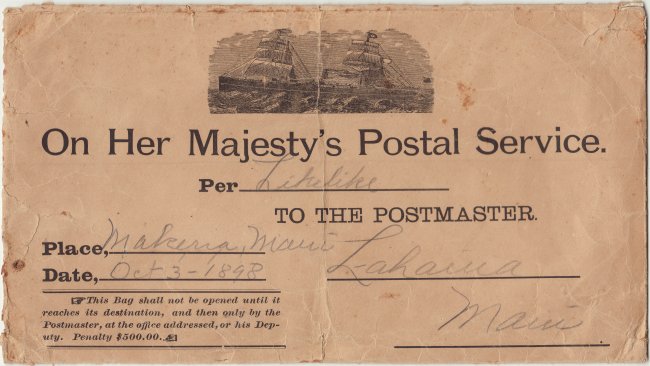
|
|
Official paper letter bag dated Oct. 3, 1898, addressed per the steamship Likelike via Makena to the postmaster of Lahaina. During the late 1890s, letters for a local post office were sent from Honolulu enclosed in paper bags such as this one, measuring 10”x6⅓.” It bears a penalty notice warning that anyone other the designated postmaster would be fined $500 for opening the bag.
|
|
|
281.011
30mm double lined outer and single lined inner circles
Color: Purple
Rarity: 1RRR; six strikes are in my record.
Usage: June __, 1897 to August 7, 1900
The last recorded strike is under U. S. Post Office Department administration.
|
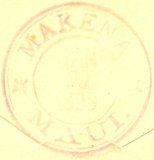
January 20, 1899
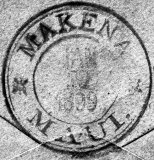
January 20, 1899
(retroReveal enhanced)
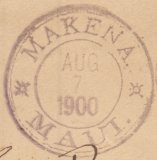
August 7, 1900
Territorial use
|
|

|
Nahiku, Hana District
"the sevens" (referring to the districts in the area)
1899-1900
Village situated in a valley on the north west coast of East Maui and center for rubber cultivation.
|
|
|
Postmaster: R. H. Worrall (1899-1900)
Mail service was by the semi-monthly overland carrier.
|
|
253.01
27mm double lined circle
Color: Purple
Scarcity: 2, 16 strikes are in my record.
Usage: August 4, 1899 – August 24, 1900
The last dates are during the U.S. Post Office administration.
|
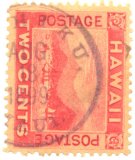
August 18, 1899
(Courtesy of Gary Peters)
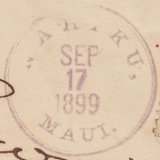
September 17, 1899
(Courtesy of Gary Peters)
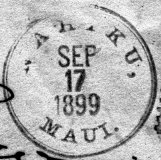
September 17, 1899
(retroReveal enhanced)
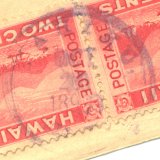
October 20, 1899
(Courtesy of Phil Kay)
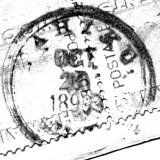
October 20, 1899
(retroReveal enhanced)
|
|

|
Nuu, Hana District
"terrace"
1858-1863
A small ranching village just west of Kaupo (see Kaupo map) on the south slope of Haleakala, East Maui.
Postmaster: A Garrett (1858). A postmaster listing for Garrett at Nuu in some references is curious and likely an error.
No postmarks are known.
|

|
Olowalu, Lahaina District
"many hills"
1886-1900
Village on the south coast of West Maui and site of a plantation owned by G. Armstrong & Co. Mail service was by the overland carrier between Lahaina and Wailuku.
|
|
|
Postmasters: August Hanneberg (1886); Sam Lung (1894-1900). Stamp sales in 1898 were unrecorded and no salary was allotted for the postmaster. PMG skipped this part of East Maui on his 1893 trip and made no mention of a postal facility here. (Hawaiian Gazette, October 17, 1893, p. 10.)
No postmarks are known.
|

|
Paia, Wailuku District
"noisy" [Pukui]; "fish yard" [Davey]
1881-1900
Located in the northeast section of Maui's isthmus (see area map at Haiku). Paia was the eastern terminus of the Kahului Railroad from September 21, 1880 until the extension to Haiku was opened in 1917. Paia became the prominent town of the Makawao District after aqueducts were completed in the late 1870s to bring enough water to the isthmus for growing sugar cane. Site of the Alexander & Baldwin sugar plantation, later known as Paia Plantation.
|
|
|
Postmasters: Chas. H. Dickey (1882-1888)[store owner]; G. Heinemann (1889-1890)[general merchant]; H. Laws (1891-1892)[Paia Plantation bookkeeper]; J. W. Colville (1892-1896; Laws continued as Colville’s clerk, D.C. Lindsay became clerk by early 1895)[Paia Plantation manager]; and D.C. Lindsay (1897-1900)[Paia Plantation overseer].
Dickey owned a store in Paia and the post office was kept there until it moved to the Paia Plantation office while Laws was postmaster. Postal affairs of Paia, Haiku and Hamakuapoko were closely linked (see the text at Haiku for more detail). Paia was a busy office, judging from a November, 1889 letter from PM Heinemann to PMG Wundenburg. Heinemann was urging an expansion of the Paia office but he doesn’t seem to exaggerate the work. He wrote: “… two trains run daily, and during the six months the sugar season lasts, three trains will run, which again means increased Post Office work, as letters pertaining to shipping business will go frequently between all parties, and they expect them to go forward by first chance. There is always more or less Money Order money on hand …” Heinemann described the difficulty of keeping the post office and attending to his business at the same time and proposed a clerk. He went on to describe the post office work: “The receiving of mails from all parts, and the dispatching to all points of the compass, keeping track of the mail carriers and pay them off, dispatch extra mails, and besides all that, to handle 100 letters daily (average) outside of Honolulu mails, taking care of the Postal Savings bank etc ad infinitum, and ad nauseum.” Later he added “keep stamp account” to his duties and handling all the transient mail to and from Honolulu.
PMG Oat described Paia as a post and money order office in his 1893 trip report and that daily mails were dispatched to the various points beyond. (Hawaiian Gazette, October 17, 1893, p. 10.)
Stamp sales in 1884-1885 were about $215 annually and grew to $420 in 1898. In May, 1889, the Paia PM said he was out of stamps and sent unstamped letters to Honolulu. In July of the same year, he requested “Registered” and “Too late” handstamps.
|
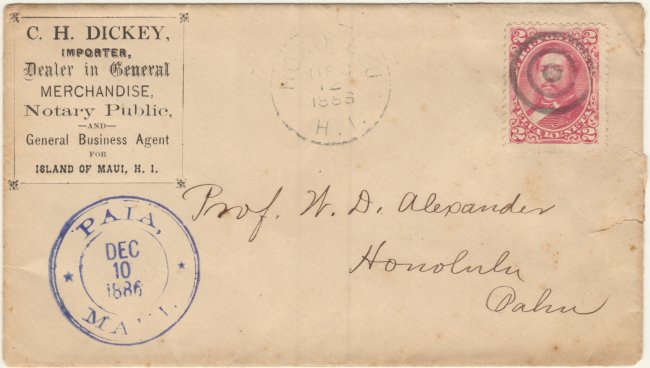
|
|
C.H. Dickey used this printed caché to advertise his stores at Haiku and Paia. This cover was marked December 10, 1886 with Paia style 281.013, and franked with Hawaii Scott No. 43 featuring a portrait of King Kalakaua.
|
|
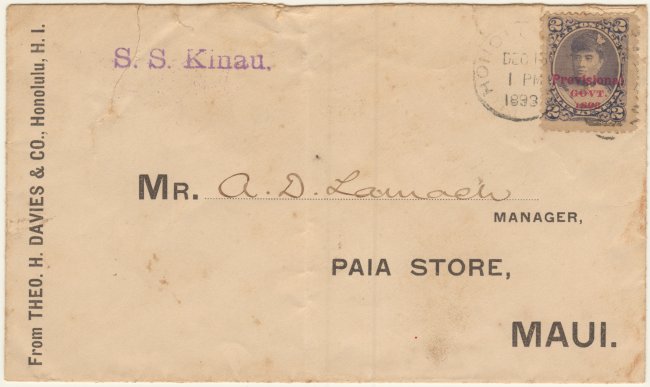
|
|
Cover addressed to the Paia Store, postmarked December 15, 1893 at Honolulu (type 231.72) and on the reverse at the Paia, December 16, 1893 (type 282.011). The steamship Kinau left Honolulu on December 15 at 2 P.M. for Maui and Hawaii. A 2¢ Queen Liliuokalani overprinted stamp (Scott #57) franked the envelope preprinted by Theo. H. Davies & Co., a major Honolulu commercial merchant and factor. The S.S.Kinau handstamp may have been applied at the T.H. Davies office as a direction to put the letter aboard the Kinau.
|
|
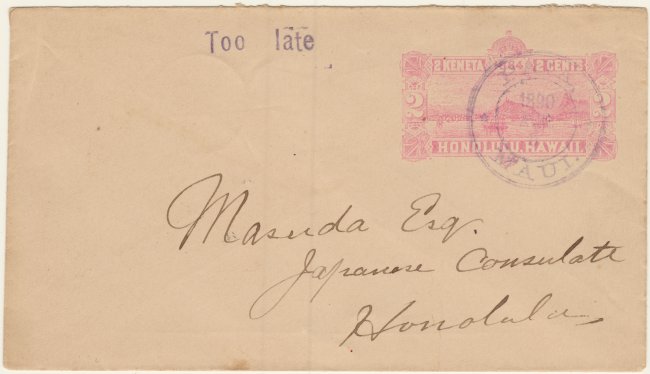
|
|
Postmarked August 6, 1890 at Paia with type 282.013 on a pale pink 2¢ stamped envelope (Scott U2c; PS-23); also marked “Too late” at Paia with the only documented strike of the “Too late” marker PM Heinemann requested from Honolulu in July, 1889. “Too late” meant a letter arrived at the Paia post office too late to catch the train for Kahului in time for the next steamship.
|
|
|
801
manuscript
Color: Black
Rarity: 1RRRR, five examples are in my record.
Noted on Scott Nos. 30a and 33
|
|
|

|
|
282.013
33mm double lined outer and single lined inner circles; small stars; tall, thin dates
Color: Purple, Blue,
Black
Estimated: 6
Usage: August __, 1881 to March __, 1893
|
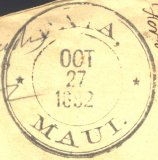
October 27, 1882, black
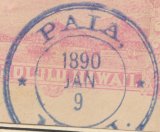
January 9, 1890, blue
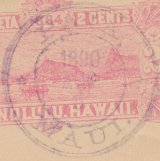
August 6, 1890, purple
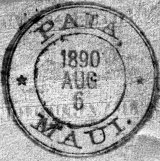
August 6, 1890
(retroReveal enhanced)
|
|
|

|
|
281.013
30mm double lined outer and single lined inner circles; large stars; short, thick dates
Color: Blue, Purple
Estimated: 6
Usage: February 17, 1887 to October 9, 1890
Blue strikes are noted to June, 1888.
The "9" in the October 9, 1890 strike is added in manuscript.
|
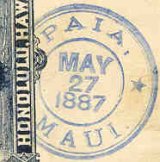
May 27, 1887
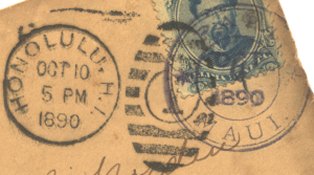
Date for the day failed; supplied by a manuscript “9”
October 9, 1890
(Courtesy of Gary Peters)
|
|

|
|
281.011
30mm double lined outer and single lined inner circles; year date often is illegible
Color: Purple, Blue, Black
Estimated: 7
Usage: March __, 1893 to June __, 1897
Blue is noted on a Scott No. 75; Black is noted January 25, 1895
|
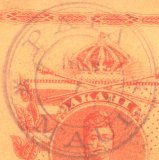
November 7, 1893
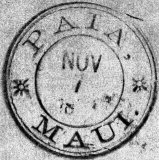
November 7, 1893
(retroReveal enhanced)
|
|

|
|
253.9a1
27mm double lined circle; duplex cancel
Color: Purple, Black
Estimated: 7
Usage: January _, 1897 – August 12, 1899
Type 253.9a1 (a duplex marking) was previously listed as January 1897 to June 12, 1900. A similar but different marking without duplex was used toward the end of this period, newly listed as 253.01 below.
Between the two marks, the letters in Paia and Maui are spaced differently enough to change how the letters of Maui orient toward Paia: a) In 253.9a1, the ”I” of Maui points to the right side of the 1st “A” of Paia, but in 253.01, the “I” of Maui points to the right side of the “P” in Paia; b) in type 253.9a1, the “A” of Maui points to the space between the “I” and 2nd “A” of Paia, but in type 253.01, the “A” of Maui points to the space between the 1st “A” and “I” of Paia. There are other small differences. Below is a comparison of the two marks, courtesy of Jim Shaffer who noticed the difference.
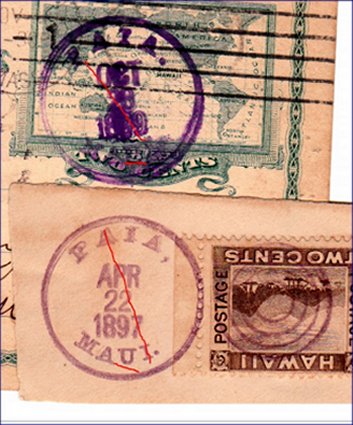
Type 253.01 is on top, 253.9a1 is below. These scans show the “I/A” orientation created by the difference in letter spacing. (Courtesy of James Shaffer)
Usage gap: August 12, 1899 is the latest use I can confirm of 253.9a1. The earliest date I have confirmed for 253.01 is October 17, 1899. Strikes reported as 253.9a1 and dated after mid-October, 1899 may all be 253.01. Future reports of dates between August 12 and October 17, 1899 would narrow this gap.
The duplex of type 253.9a1 sometimes failed to print and those strikes can be confused with type 253.01 unless care is taken to note the differences between the two marks.
|
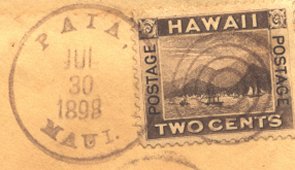
July 30, 1898
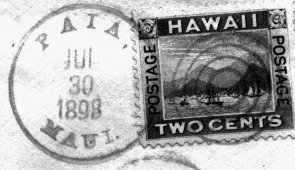
July 30, 1898
(retroReveal enhanced)
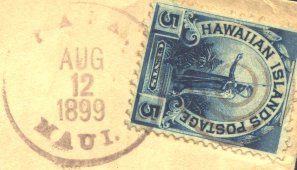
August 12, 1899
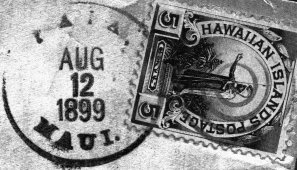
August 12, 1899
(retroReveal enhanced)
|
|

|
|
253.01
27mm double lined circle
Color: Purple, Black
Estimated: 2
Usage: October 18, 1899 – June 12, 1900
No duplex target cancel. See 253.9a1 notes for other differences.
|
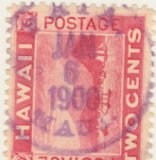
January 6, 1900
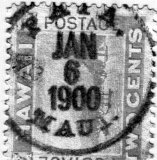
January 6, 1900
(retroReveal enhanced)
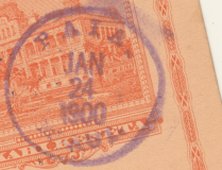
January 24, 1900
|
|

|
Paihiihi, ?
"neat, tidy"
1878-1879
Postmaster: W. E. Rinnell (1878-1879)
Listed in some references but this location and nature of any postal facility at a place by this name is unknown.
No postmarks are known.
|

|
Pauwela, Makawao District
"burned up"
1894-1900
A small village just northeast of Haiku.
|
|
|
Postmasters: W.B. Kikoopaoa (_-1894); D. W. Kakopaa (1894); Kukopaa (1894), P. Keaupuni (1894-1900). PMG Oat described Pauwela as a postal agency in his 1893 trip report. Keaupuni was appointed PM in 1894.
Before a postal agency was approved, mail was left unattended at a store. Stamp sales in 1898 were unrecorded, but the postal agent was paid a salary of $5 per month.
No postmark known.
|

|
Peahi, Makawao District
"fan"
1894-1900
Plantation town on the north west coast of East Maui, between Haiku and Huelo.
|
|
|
Postmaster: T. K. Pa (1894-1900).
Stamp sales in 1898 were unrecorded, but the postmaster was paid a salary of $5. Thomas K. Pa was the Peahi policeman as well as postmaster. PMG Oat made no mention of Peahi in his 1893 trip report. (Hawaiian Gazette, October 17, 1893, p. 10.)
|
|
253.02
27mm double lined circle
Color: Purple
Rarity: 1RRR, nine strikes are in my record.
Usage: January 29, 1897 – May 12, 1900
|
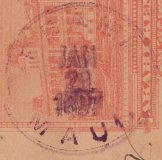
January 29, 1897
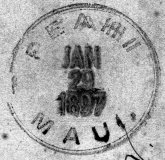
January 29, 1897
(retroReveal enhanced)
(Courtesy of Gary Peters)
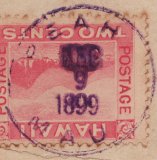
December 9, 1899
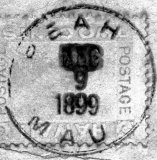
December 9, 1899
(retroReveal enhanced)
|
|
|
|
 Back to Islands of Maui, Molokai and Lanai.
Back to Islands of Maui, Molokai and Lanai.
|
|

|
|
Copyright © 1999 - 2019 POST OFFICE IN PARADISE. All rights reserved.
|
|